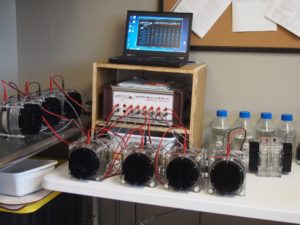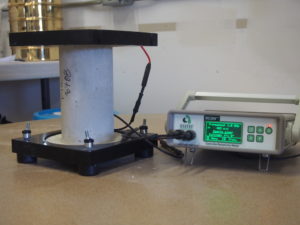For the most part, so-called concrete “permeability” tests measure something other than permeability. Permeability is the ease with which fluids can move through a porous material. That matters because most concrete deterioration is due to the penetration of water or some other harmful substance such as sulfate– or chloride ions into the concrete.
Water penetration is directly or indirectly the cause of the majority of disintegrations in concrete and the degree to which water penetration is permitted by the texture of any concrete is a direct measure of its strength and endurance. —Concrete Engineers’ Handbook, 1918
For example, freeze-thaw damage occurs when water inside the concrete freezes. When water freezes, it expands. We entrain air in the concrete to give the water somewhere to go so it doesn’t destroy the concrete.
Corrosion of the reinforcing bars is usually related to chloride ions from road salts or seawater. The chlorides act as catalysts to the corrosion reactions. However, water is necessary for the chlorides to migrate in, and for the reactions to take place.
One way to keep water out of the concrete is to design the structure for durability. This pertains to such matters as promoting drainage and limiting crack widths. The other is to design the concrete for durability. That means you need to test its ability to resist the ingress of water and other harmful substances.
What concrete “permeability” tests are there?

The most common test that relates to durability of concrete is ASTM C1202, which people commonly (and mistakenly) call the Rapid Chloride Permeability test. For a detailed description of the test method, click here.
ASTM C1202 uses the electrical conductivity of the concrete as a surrogate for chloride ion ingress. Dr. David Whiting, the developer of the test method, would say that it was a good way to compare similar concretes. As more chlorides enter the pore solution, the concrete becomes more conductive. However, other factors can affect the pore solution chemistry without necessarily affecting the chloride concentration. Changing the proportions of fly ash, silica fume, and slag cement will affect the pore solution—and the electrical conductivity.
To get a good view of chloride ion migration into concrete, ASTM C1556 is useful. In this test a salt solution of known concentration is ponded on a slab of concrete. For concrete designed for durability, an exposure period of at least six months is necessary. Milling 1-mm layers from a core of the concrete (a useful deviation from the standard test method) yields a chloride concentration profile. ASTM C1556 is too time-consuming to use for quality control, but it is appropriate for research and more nuanced than ASTM C1202.
Improvements on ASTM C1202
NT Build 492 takes slightly longer to perform than ASTM C1202, but it has the advantage of yielding data to calculate an apparent diffusion coefficient. That means it can provide data for service life prediction as well.
ASTM C1556 determines the bulk diffusion coefficient of concrete. Its precise sampling technique gives enough data to calculate an apparent diffusion coefficient. As with NT Build 492, we can use these data to predict the service life of a concrete structure. The data from ASTM C1556 and NT Build 492 are comparable but not identical.
Calculating the apparent diffusion coefficient
Fick’s Second Law, which we use to calculate the apparent diffusion coefficient from the chloride concentration profile, depends on several assumptions:
- The material through which diffusion takes place is permeable and homogeneous.
- Its diffusion properties do not change with time or with the concentration of the diffusant.
- No chemical reaction or physical binding of the diffusant occurs.
In reality, none of the above assumptions is valid. Concrete is permeable, but not homogeneous. Its diffusion properties change with time, as the cementitious materials continue to hydrate. And, particularly when slag cement is present, the chlorides may be bound in the concrete. That’s why we refer to an apparent diffusion coefficient—mathematically it looks and acts like one, but physically it’s not the same.
Real concrete permeability tests—sort of
ASTM C642 measures the adsorption of bulk concrete. In this test, you dry a concrete specimen to constant mass in an oven, then immerse it in water until it again reaches constant mass. Then you boil it in water for 5 hours, weigh it again, and determine the absorption. Of course in this test the oven drying may induce cracking, which will affect the absorption measurement.
In most cases, the absorption of water from the surface of the concrete is more meaningful than the bulk absorption. ASTM C1585 measures the rate of absorption over time. A 4-in. diameter cylinder or core is conditioned to an internal relative humidity of 50 to 70% and then sealed on all but one surface. The changes in mass over the course of seven days’ exposure to water indicate the rate of absorption.
Some researchers have developed their own tests involving sealing a concrete specimen in place and forcing water under pressure through the specimen. The less permeable the concrete, the more pressure you need—and the more difficult it is to maintain the seal so the water doesn’t just flow around the specimen. The high pressures can also be dangerous if the apparatus fails during the test.
Researchers have used fluids other than water for permeability tests. Oxygen, for example, is easier to use than water. However, the simplifying assumption of laminar flow is not strictly valid when the gas moves through very small pores in the concrete.
Electrical test methods

Most of the newer concrete “permeability” tests use electrical properties as surrogates for permeability. One of these is ASTM C1760, which measures the resistivity of the concrete. In addition to being quick and easy to do, this test can be performed repeatedly on the same concrete specimen. That means you can use it to monitor changes in the concrete as it hydrates.
Overall, any test will have advantages and disadvantages. It’s best to use more than one kind of test so you have some checks and balances. It’s also important to understand what any test does or does not measure. We can design a test program that’s right for your project and help you understand what the results mean.
